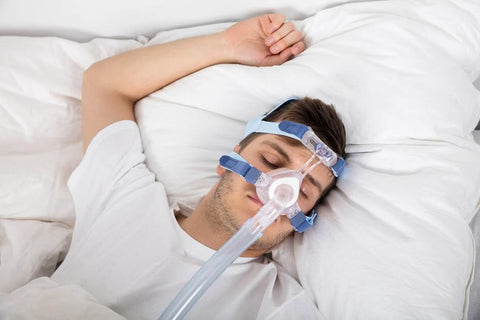Sleep apnea is a sleep disorder that many people struggle with. There are several types of sleep apnea such as obstructive sleep apnea (OSA) and central sleep apnea (CSA). You might assume that sleep apnea is quite benign and would only result in you struggling to stay awake and alert throughout the day. Unfortunately, sleep apnea can escalate to a point wherein it is life threatening. Due to this, in addition to the decline in quality of life brought about by poor sleep quality, it might be best to discuss possible treatments with your doctor.
For moderate to severe cases, doctors or therapists may recommend the use of sleep devices such as PAP Therapy Machines like CPAP, BiPAP or APAP Machines to be used to help alleviate any breathing issues during sleep.
Some Things to Know About CPAP Machines
CPAP Machines, or Continuous Positive Airway Pressure Machines, are the most commonly prescribed sleep treatment machine for sleep apnea. This particular device is helpful because it utilizes positive air pressure to keep airways open during sleep, which helps maintain a steady flow of oxygen. It is key to understand that CPAP Machines produce steady airflow and must be reset and calibrated to adjust the air pressure intensity.
The CPAP Machine pumps air through tubing and into a mask that is worn on the face. There are several different mask designs and accessories like cushions and headgear that may help improve the quality of the experience.
You can either use a nasal pillow mask, nasal mask, or full mask in conjunction with a CPAP machine. A nasal pillow mask includes a small cushion that helps seal off your nostril area. It covers a much smaller area which makes it comfortable for users who wear glasses or who have a lot of facial hair.
A nasal mask fits around the entire nasal area and is designed for individuals who move around a lot in their sleep.
Lastly, a full face mask covers the entire nose and mouth area. Because it also covers the mouth, it is often a good option for mouth breathers and for those who have nasal blockages which may render nasal masks and nasal pillow masks to be ineffective.

How Does APAP Therapy Work?
Automatic Positive Airway Pressure, also often referred to as APAP, is another option for sleep therapy. Like CPAP, it generates positive airflow to help keep airways open during sleep. It is also used in conjunction with tubing, masks, and other accessories.
As mentioned, CPAP Machines require users to reset and calibrate settings in order to adjust the air pressure. APAP Machines, on the other hand, are much easier to use because they automatically adjust airflow throughout the night depending on the patient’s needs. This is achieved through measuring the resistance exerted with each breath. Through this mechanism, APAP machines may increase the pressure when it senses any decrease in airflow.
Because of how APAP Devices are much more flexible, it is an ideal option for patients whose breathing patterns tend to vary throughout the night. These variations in breathing may occur alongside changes in position or as a side effect of certain medications. Breathing patterns also vary depending on which stage of sleep you are in.
APAP Machines seem to be a great option due to its ability to adjust to your needs. However, it is not the safest option for all apneic patients. Doctors discourage the use of APAP Machines for individuals who suffer from chronic obstructive pulmonary disorder, congestive heart failure, carbon dioxide retention, obesity hypoventilation syndrome, or daytime hypoxemia. In addition to this, it is also more expensive compared to their simpler CPAP counterparts.

Understanding BiPAP Machines
BiPAP, or Bilevel Positive Airway Pressure, allows the user to adjust different pressure settings for inhaling or exhaling. These PAP machines are also used with tubing, masks, and other accessories. Often, BiPAP Devices are used by CPAP intolerant apneic individuals who find it difficult to exhale when using CPAP Machines. This is because the capacity of BiPAP Machines to accommodate two different pressure settings for inhaling and exhaling allows the user to set the higher for breathing in and lower for breathing out.
BiPAP Machines are also ideal for individuals who suffer from hypercapnia, a condition wherein the patient has excessive carbon dioxide buildup in the blood. This often occurs as a complication of lung diseases like cystic fibrosis, bronchiectasis, emphysema, and COPD. In addition to this, BiPAP Machines are also recommended for patients who suffer from central sleep apnea and some neuromuscular diseases due to its mechanism that helps the patient initiate breath.
Some mild symptoms of hypercapnia include flushed skin, disorientation, dizziness, fatigue, and headaches. However, this condition can also be more severe and occur alongside seizures, passing out, arrhythmia (irregular heartbeat), and even paranoia or depression.
It should be noted that BiPAP Machines are often several times more expensive than CPAP machines. Additionally, users also report that it requires a considerable adjustment period due to its varying pressures per breath, which may feel uncomfortable at first.
I’m Still Confused. Which Device Should I Use?

The safest way to figure out which positive airway pressure machine is best for you is to consult with healthcare professionals. Moreover, you might be recommended to undergo an extensive sleep study which would help your doctors and therapists evaluate your needs based on a very detailed report.
Additionally, it is also important to consider other factors such as budget, insurance, comfort, and quality of life. A machine or PAP setup that works for one person, may not be the best option for you.
Lastly, patients must not be reliant solely on their PAP Machines in order to overcome their sleep apnea. Outcomes for PAP Machine use are best when combined with accommodating healthier habits to improve one’s overall lifestyle.


1 comment
David
Still very confused about what is best, drawbacks to all three, by now it should be possible to correctly diagnose a person.